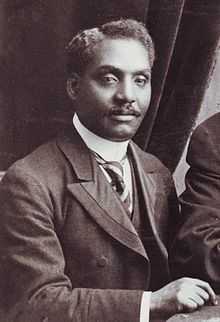John Alcindor

John Alcindor (8 or 9 July 1873–25 October 1924)[1] was a physician from Trinidad who settled in London. He is known for his role in the African Progress Union.
Life
He was educated at Saint Mary's College and then went as a medical student to Edinburgh University on a scholarship.[2] He graduated there with a medical degree in 1899.[3] He then worked in London hospitals, going into practice on his own around 1907.[4] At this period he played cricket, as a wicket keeper for London teams.[5]
Refused a place in the Royal Army Medical Corps, Alcindor was awarded a Red Cross medal for his work with the wounded at London rail stations during World War I.[6]
Alcindor served as senior district medical officer in Paddington from 1921 to his death.[7]
Activism
Alcindor associated in the late 1890s with the group around Henry Sylvester-Williams and his African Association. They were behind the First Pan-African Conference in 1900, which he attended in London, as a delegate from the Afro-West Indian Society.[3][8][9]
Alcindor became the second president of the African Progress Union in 1921, succeeding John Archer.[4]
Alcindor presided on the first day of the 2nd Pan-African Congress in 1921, with Rev. W. H. Jernagin.[10] He spoke at the 3rd Pan-African Congress in 1923.[11][12]
Legacy
In July 2014 a blue plaque in his honour was unveiled at the site of Alcindor's surgery,[13] which is now the Medical Centre in Harrow Road, Paddington.[14][15]
References
- ↑ Jeffrey Green, "Alcindor, John (1873–1924)", Oxford Dictionary of National Biography, Oxford University Press, 2004; online edn, January 2008 accessed 15 January 2015
- ↑ Robert A. Hill; Marcus Garvey; Robert A. Hill Marcus Garvey Universal Negro Improvement Association (1995). The Marcus Garvey and Universal Negro Improvement Association Papers: Africa for the Africans 1921–1922. University of California Press. p. 168 note 2. ISBN 978-0-520-20211-5.
- ↑ 3.0 3.1 Peter Fryer (1984). Staying Power: The History of Black People in Britain. University of Alberta. p. 299. ISBN 978-0-86104-749-9.
- ↑ 4.0 4.1 Green, Jeffrey. Oxford Dictionary of National Biography (online ed.). Oxford University Press. doi:10.1093/ref:odnb/57173. (Subscription or UK public library membership required.)
- ↑ Jeffrey P. Green (1998). Black Edwardians: Black People in Britain, 1901–1914. Psychology Press. pp. 181–. ISBN 978-0-7146-4871-2.
- ↑ Carole Elizabeth Boyce Davies (2008). Encyclopedia of the African Diaspora: Origins, Experiences, and Culture: Origins, Experiences, and Culture. ABC-CLIO. p. 928. ISBN 978-1-85109-705-0.
- ↑ Judith Ann-Marie Byfield; LaRay Denzer; Anthea Morrison (2010). Gendering the African Diaspora: Women, Culture, and Historical Change in the Caribbean and Nigerian Hinterland. Indiana University Press. p. 277 note 24. ISBN 978-0-253-35416-7.
- ↑ Jonathan Derrick (2008). Africa's "agitators": Militant Anti-colonialism in Africa and the West, 1918–1939. Columbia University Press. p. 23. ISBN 978-0-231-70056-6.
- ↑ Felix Driver; David Gilbert (2003). Imperial Cities: Landscape, Display and Identity. Manchester University Press. p. 266 note 36. ISBN 978-0-7190-6497-5.
- ↑ Venetria K. Patton; Patton, Venetria K., Maureen Honey (2001). Double-Take: A Revisionist Harlem Renaissance Anthology. Rutgers University Press. p. 76. ISBN 978-0-8135-2930-1.
- ↑ Peter Fryer (1984). Staying Power. p. 323.
- ↑ The Crisis Publishing Company, Inc. (1924). The Crisis. The Crisis Publishing Company, Inc. p. 120. ISSN 0011-1422.
- ↑ "Recognition at last for the ‘black doctor of Paddington’", British Red Cross, 16 July 2014.
- ↑ Goolistan Cooper, "Plaque honours Black Doctor of Paddington", GoWestLondon, 24 July 2014.
- ↑ "World War One ‘Black Doctor’ hailed as World War One hero with new heritage blue plaque", BEN TV, 10 July 2014.